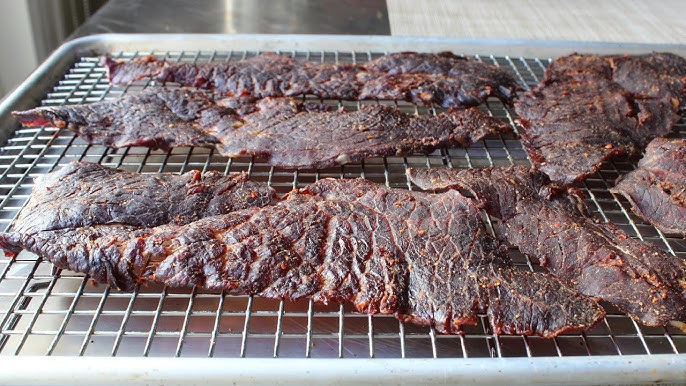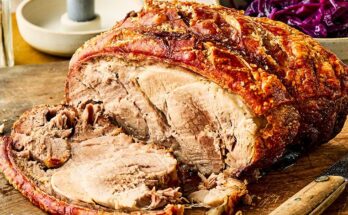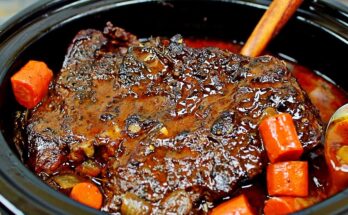Jerky Recipe: There’s something incredibly satisfying about making your own jerky. It’s not just a snack; it’s a labor of love that packs a punch of flavor, texture, and nutrition.
Sure, you could grab a bag from the store, but once you experience the depth of taste and the satisfaction of crafting your own jerky, you’ll wonder why you didn’t start sooner.
Plus, making it at home lets you control everything — from the cut of meat to the spices used. Imagine being able to create your very own signature jerky flavor! Let’s dive into this delicious world.
Why Make Jerky at Home?
Homemade jerky isn’t just about saving a few bucks, although that’s definitely a bonus. It’s about quality and customization. Store-bought jerky often contains preservatives, excess sugar, and artificial flavors that you can easily skip when making it yourself. You can create a healthier, leaner version tailored exactly to your taste buds. Want it spicy? Add more chili. Prefer a smoky hint? Toss in some smoked paprika. Making jerky at home also allows you to experiment endlessly, perfecting your craft over time and maybe even becoming the go-to jerky expert among your friends and family.
Essential Equipment for Making Jerky
You don’t need a high-end kitchen to start making jerky, but a few tools will make the process smoother:
- Sharp knife: For trimming fat and slicing meat thinly and evenly.
- Cutting board: Dedicated to raw meat to avoid contamination.
- Large mixing bowls: For marinating the meat properly.
- Dehydrator: The easiest and most reliable method for drying meat.
- Oven: A great alternative if you don’t own a dehydrator.
- Wire racks and baking sheets: Useful for oven-drying jerky.
- Airtight containers or vacuum sealer: For proper storage.
Having the right gear ensures that your jerky turns out flavorful, safe, and delicious every single time.
Choosing the Best Meat for Jerky
Choosing the right meat is crucial. Your jerky’s texture and flavor depend heavily on it.
Top Meat Choices for the Perfect Jerky
- Beef: The classic choice. Go for lean cuts like top round, bottom round, sirloin tip, flank steak, or eye of round.
- Turkey: A leaner alternative for those watching their red meat intake.
- Venison: Perfect for those who love a gamey, earthy flavor.
- Pork: Surprisingly good for jerky when using lean cuts like tenderloin.
Always pick the leanest meat possible. Fat doesn’t dehydrate well and can spoil your jerky faster.
Preparing the Meat: Tips and Tricks
Once you’ve selected your meat, preparation is key. Start by trimming off every bit of visible fat. Fat doesn’t dry out like meat does, and leaving it on can cause your jerky to spoil quickly. Then, freeze the meat for about 1-2 hours. Slightly frozen meat is much easier to slice thinly and evenly, which is vital for consistent drying. Aim for slices about 1/8 to 1/4 inch thick. Thinner slices will be chewier and dry faster, while slightly thicker ones will have a more tender bite.
Creating the Perfect Marinade
Marinade is where your jerky gets most of its flavor, so don’t skip this step or rush through it.
Must-Have Ingredients for a Flavorful Marinade
A basic but amazing marinade usually includes:
- Soy sauce: For that salty, umami base.
- Worcestershire sauce: Adds depth and tanginess.
- Brown sugar or honey: Balances the saltiness and adds a touch of sweetness.
- Black pepper, garlic powder, and onion powder: Classic spices that never go wrong.
- Red pepper flakes: For a spicy kick.
- Liquid smoke: If you’re not using a smoker but still crave that smoky flavor.
Feel free to get creative! Add ginger, chili paste, cumin, or whatever you love.
Marinating Techniques to Enhance Flavor
After mixing your marinade ingredients in a large bowl, toss in your meat slices, ensuring each piece is fully coated. Then transfer everything into a zip-top bag or a large container. Refrigerate for at least 6 hours — overnight is even better! The longer the meat marinates, the deeper the flavors penetrate. Shake or turn the bag occasionally to make sure all slices get their fair share of flavor.
Drying Methods Explained
Now that your meat is marinated and bursting with flavor, it’s time to dry it into delicious jerky.
Using a Dehydrator
A dehydrator is the easiest and most efficient way to make jerky. Simply lay the marinated meat strips in a single layer on the trays, making sure they don’t overlap. Set the dehydrator to 160°F (70°C) and let it run for 4-8 hours, checking occasionally. You’ll know the jerky is done when it bends without breaking and feels dry to the touch but still slightly pliable.
Oven-Drying Jerky
No dehydrator? No problem. Preheat your oven to 170°F (75°C) or the lowest setting possible. Place the meat strips directly on the oven racks, with a baking sheet lined with foil underneath to catch drips. Prop the oven door open slightly with a wooden spoon to let moisture escape. Drying can take 4-6 hours, depending on your oven and the thickness of the meat slices. Keep an eye on it!
Traditional Smoking Method
For those who crave authentic, smoky jerky, using a smoker is unbeatable. Set your smoker to around 160°F (70°C) and use woods like hickory, mesquite, or apple for flavor. Smoking will take a bit longer, usually 6-10 hours, but the deep, rich flavor it imparts is well worth the wait.
Storing and Enjoying Your Homemade Jerky
Once your jerky is dried to perfection, you might think the hard work is over — but proper storage is just as crucial if you want it to stay fresh, tasty, and safe to eat.
Proper Storage Techniques
First, let your jerky cool completely. Storing warm jerky can cause condensation, which might lead to mold. Once cooled, you have several options:
- Airtight containers: Glass jars, Tupperware, or vacuum-sealed bags work wonders.
- Vacuum sealing: This is the gold standard for long-term storage. Removing all air extends shelf life and keeps flavors locked in.
- Refrigeration and Freezing: If you plan to keep your jerky longer than a week or two, refrigerate or freeze it. Properly vacuum-sealed jerky can last in the fridge for months and even longer in the freezer.
Label your storage bags or containers with the date you made the jerky. Trust me, time flies, and you’ll be grateful you can track how long it’s been sitting.
Creative Ways to Enjoy Your Jerky
Sure, gnawing on a stick of jerky is classic, but why stop there? Here are some fun ways to incorporate jerky into your meals:
- Trail Mix Boost: Chop your jerky into bite-sized pieces and toss them into your favorite trail mix for a protein punch.
- Salad Topper: Jerky can add a savory, chewy texture to fresh salads.
- Omelet Filling: Spice up your breakfast by tossing jerky strips into an omelet.
- Sandwich Upgrade: Layer some jerky slices into sandwiches or wraps for extra flavor.
- Soup Enhancer: Toss a few pieces into stews or soups — they’ll soften and add a smoky flavor.
Jerky isn’t just a snack; it’s a versatile ingredient that deserves a spot in your everyday meals.
FAQs about Jerky Recipe
What is the best meat to use for homemade jerky?
The best cuts for jerky are lean meats like beef round, sirloin, or brisket. Less fat means your jerky will last longer and have a better texture.
How long does it take to make jerky?
Depending on your drying method, it usually takes 4 to 8 hours. Dehydrators and ovens work faster, while air-drying methods can take a bit longer.
Can I make jerky without a dehydrator?
Yes! You can easily make jerky in a conventional oven set at a low temperature (around 160°F or 70°C) or even on a smoker for added flavor.
How do I know when jerky is done?
Jerky is done when it’s dry but still slightly flexible. It shouldn’t snap when bent, but it shouldn’t feel soft or squishy either.
How should I store homemade jerky?
Store your jerky in an airtight container or vacuum-sealed bag. Keep it in a cool, dry place for up to two weeks, or refrigerate it for longer shelf life.
Can I freeze jerky?
Absolutely! Freezing jerky can extend its shelf life up to 6 months. Just make sure it’s properly sealed to prevent freezer burn.
What seasonings work best for jerky?
Classic jerky seasonings include soy sauce, Worcestershire sauce, black pepper, garlic powder, and brown sugar. Feel free to get creative with spices like cayenne, paprika, or liquid smoke!
Conclusion
Making your own jerky might seem intimidating at first, but once you get the hang of it, it’s downright addictive. From picking the best cuts of meat to creating mouth-watering marinades and mastering the art of drying, each step brings you closer to that satisfying bite of homemade goodness. Plus, you’re in full control — no mystery ingredients, no preservatives, just pure, flavorful jerky made exactly how you love it. Whether you’re prepping snacks for a camping trip, looking for a high-protein everyday treat, or simply diving into a new culinary adventure, homemade jerky is a skill worth mastering.
Give it a try, experiment with flavors, and soon, you’ll be making jerky that’s better than anything you can find at the store. Happy jerky-making!



